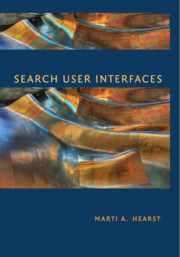Book contents
- Frontmatter
- Contents
- Preface
- 1 The Design of Search User Interfaces
- 2 The Evaluation of Search User Interfaces
- 3 Models of the Information Seeking Process
- 4 Query Specification
- 5 Presentation of Search Results
- 6 Query Reformulation
- 7 Supporting the Search Process
- 8 Integrating Navigation with Search
- 9 Personalization in Search
- 10 Information Visualization for Search Interfaces
- 11 Information Visualization for Text Analysis
- 12 Emerging Trends in Search Interfaces
- Appendix: Additional Copyright Notices
- Bibliography
- Index
- Author Index
- Plate section
1 - The Design of Search User Interfaces
Published online by Cambridge University Press: 05 March 2013
- Frontmatter
- Contents
- Preface
- 1 The Design of Search User Interfaces
- 2 The Evaluation of Search User Interfaces
- 3 Models of the Information Seeking Process
- 4 Query Specification
- 5 Presentation of Search Results
- 6 Query Reformulation
- 7 Supporting the Search Process
- 8 Integrating Navigation with Search
- 9 Personalization in Search
- 10 Information Visualization for Search Interfaces
- 11 Information Visualization for Text Analysis
- 12 Emerging Trends in Search Interfaces
- Appendix: Additional Copyright Notices
- Bibliography
- Index
- Author Index
- Plate section
Summary
Keeping the Interface Simple
The job of the search user interface is to aid users in the expression of their information needs, in the formulation of their queries, in the understanding of their search results, and in keeping track of the progress of their information seeking efforts.
However, the typical search interface today is of the form type keywords- in-entry-form, view-results-in-a-vertical-list. A comparison of a search results page from Google in 2007 to that of Infoseek in 1997 shows that they are nearly identical (see Figure 1.1). Why is the standard interface so simple? Some important reasons for the relative simplicity and unchanging nature of the standard Web search interface are:
Search is a means towards some other end, rather than a goal in itself. When a person is looking for information, they are usually engaged in some larger task, and do not want their flow of thought interrupted by an intrusive interface.
Related to the first point, search is a mentally intensive task. When a person reads text, they are focused on that task; it is not possible to read and to think about something else at the same time. Thus, the fewer distractions while reading, the more usable the interface.
Since nearly everyone who uses the Web uses search, the interface design must be understandable and appealing to a wide variety of users of all ages, cultures and backgrounds, applied to an enormous variety of information needs.
- Type
- Chapter
- Information
- Search User Interfaces , pp. 1 - 28Publisher: Cambridge University PressPrint publication year: 2009
- 1
- Cited by



